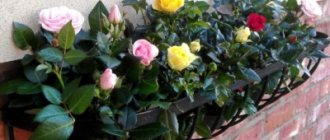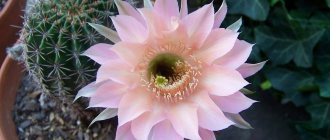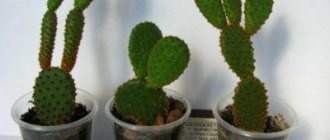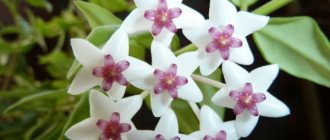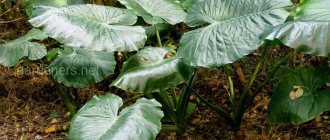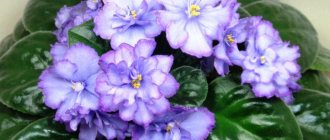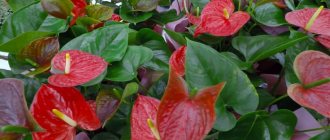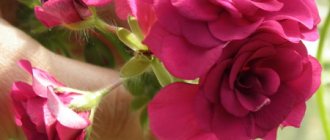The homeland of the Hatiora cactus is Brazil, or rather its tropical forests. According to data taken from various sources, this genus includes 5–10 species, and only some of them are cultivated at home. Some taxonomists believe that this plant is part of the Rhipsalis genus. At first, this genus was named “Hariota” in honor of the famous traveler and mathematician from England, Thomas Harriot, who was among the first explorers of the nature of America. However, after some time, experts realized that a completely different plant had already been called chariota, then they had to replace the name of this flower with an anagram: chariota - hatiora.
Features of an indoor flower
Hatiora is a unique plant that has neither leaves nor branches. It consists of individual segments of a flat, cylindrical or bottle shape. They are connected to each other by air membranes.
Grows in the form of a bush. The shoots are erect, but over time they begin to droop under their own weight. Additional support may be required.
It blooms with small flowers that look like bells with many small petals. Flowers appear only at the tips of the upper young shoots. On some varieties, translucent oblong berries appear after flowering.
The plant belongs to the cactus family, but it does not have spines . Instead, a fluffy white coating is visible on the shoots. Hatiora shoots are very fragile and break off easily. Therefore, you should not fiddle with it again.
Care
Caring for the plant at home is quite simple, so even a novice gardener can handle it. Hatiora is completely unpretentious and not capricious. It is enough to follow simple rules when growing it, and it will delight you with its lush flowering for a long time.
Illumination
If hatiora grows in an apartment, then it is better to keep it on windows facing east or west. The plant loves bright diffused light , the main thing is to protect it from direct sunlight.
It also feels good on the south side, but here it must be specially shaded or placed at some distance from the window. Tender shoots can get burned if hathiora is kept in full sun.
If there is not enough light, the shoots may stretch, and subsequently the plant will bloom poorly.
Temperature
Hatiora is a heat-loving plant, like all succulents. During the period of active growth and flowering, the preferred temperature is +20 – +26°C. In summer, the ideal option would be to take it out onto the balcony or open terrace. Differences between day and night temperatures are even useful for her, if they do not exceed 5-6°C. In winter, when the flower is dormant, the temperature should be lowered to +10°C.
Air humidity
Increased air humidity will have a beneficial effect on the plant, especially during the growing season. Dry air in apartments can affect the intensity of flowering. Therefore, you need to take measures for additional hydration.
The flower should be regularly sprayed or washed in the shower with warm water . In particularly hot weather, place a home humidifier next to the pot. You can immerse the plant along with the flowerpot in a container filled with wet expanded clay or small pebbles.
Trimming
Hatiora is distinguished by its widely growing crown. To create a beautiful shape, the plant should be pruned periodically. The best time for this is early spring, after the plant has finished blooming. To do this, excess parts of the shoots are removed manually. This must be done carefully by twisting at the junction of the segments. This way the flower will be less injured.
Watering
Hatiora requires watering only during the period of active growth and flowering . Water with warm and well-settled water. In this case, you need to ensure that the soil has time to dry well between waterings.
Do not allow water to stagnate. This can lead to rotting of the roots or the appearance of brown spots on the branches.
To avoid this, you need to drain the water from the pan immediately after watering. Wrinkled plant segments will indicate insufficient watering.
In winter, watering is kept to a minimum. It is enough to water the plant once every 3-4 weeks. At this time, hatiore has enough water contained in the stems. In winter, buds are formed for future flowers, and if the correct watering regime is followed, the plant will bloom very actively and profusely.
Fertilizer
They begin to fertilize hatiora from the beginning of spring until the end of flowering . They do this 2 times a month. Mineral fertilizer for succulents is chosen as a top dressing.
Please note that the fertilizer contains potassium (for bright coloring of flowers) and phosphorus (stimulates flowering). But calcium and nitrogen are undesirable. It is better to apply fertilizer in liquid form, so it is better absorbed by the plant. In winter, when the plant is dormant, there is no need to feed it.
Transfer
Young plants should be replanted annually, older plants - once every 2-3 years. If the flower is very old, then it can be replanted every 5 years .
Hatiora easily tolerates the transplant. It belongs to epiphytic plants, in which the root system is rather poorly developed and the roots are close to the surface. Therefore, choose a shallow and wide pot. Replanting should only take place after the plant stops blooming.
Be sure to place a layer of drainage at the bottom of the pot, to which you can add a little crushed charcoal. The soil should be chosen specifically for succulents. The plant requires slightly acidic or neutral soil. It should be sufficiently loose and permeable.
Transplantation is carried out by transferring the plant from one pot to another . The difference in pot sizes should be small. During transplantation, you must carefully examine the root system and remove dried or rotten parts.
How to replant
The roots of the hatiora are located superficially, and in a large volume the soil will begin to turn sour, because moisture will stagnate in the lower layers, so you need to choose a low pot, 2-2.5 cm larger in diameter than the previous one. It is washed with soap and dried, if not drainage hole, then do it. For planting, soil is suitable for succulents, cacti, or you can prepare it yourself by mixing 1 part of calcined coarse sand, turf soil, humus and 2 parts of leaf soil.
Place a mound of soil onto the drainage of washed and calcined pebbles or small stones, place the plant on it, and straighten the roots. Fill in the voids, shaking the pot slightly to remove remaining air, compact, and water. At first, keep the flower in a shaded, not hot place - adaptation is difficult in the light and at high temperatures.
A flowering hatiora should not be replanted - it will shed all its inflorescences. In the future, transplantation of a young bush is carried out at intervals of two years, of an adult - once every five years.
Reproduction methods
Hachiora is easy to propagate on your own. The procedure is best carried out in spring and summer, during active growth. There are several ways to do this:
- seeds;
- cuttings;
- vaccinations.
Propagation by seeds is the most labor-intensive and ineffective method. It is used mainly by breeders.
Cuttings
To root the plant, it is enough to break off a small part of the shoot, consisting of 3-4 segments.
It should be broken off by twisting at the thinnest point, where the barrel segments connect. Sprinkle the broken area with crushed coal. Then place the cuttings in a shaded place for a couple of days so that they dry out and then root. If you take a large fragment of a plant for rooting in order to immediately get a large flower, then it should be dried for at least a week. Some gardeners do not dry the cuttings, but place them in water. When they sprout roots they are planted.
The rooting substrate should be taken from a sand-peat mixture . Place the flower in a warm and bright place, protected from bright sun and drafts. Water with caution.
Hatiora takes root quickly. Sometimes fragile segments of the trunk can break off chaotically and, once on the soil, germinate on their own.
Graft
Reproduction by vegetative means or by grafting is a more troublesome method. It requires special skills and practice. But as a result, it produces a profusely flowering plant. It is better to graft Hatiora in the summer. As a rootstock you can take perexia spinosa.
The shoot of the rootstock, where there is a branched part, is cut off . At the point of branching, the trunk splits.
- Break off a stalk of 2-3 segments from the hatiora and sharpen its lower part.
- Then install the cutting with the pointed end instead of splitting the rootstock and secure.
- Once you are sure that the grafted plant has begun to grow, the fixing bandage can be removed.
- Place the plant in a sheltered place at a temperature of about 20°C.
The grafted plant takes root within 2-3 weeks.
Purchase of hatiora, adaptation
You can purchase a flower at a flower shop or nursery, having previously familiarized yourself with the characteristics of the species. When choosing, you need to focus on the appearance of the plant, which reflects its condition.
What to pay attention to:
- developed aerial part - the stems are elastic, uniform in color, without spots, damage, or the presence of insects;
- in a healthy plant, the branches do not break off when shaken, and the inflorescences do not fall off;
- the condition of the roots can be seen through the drainage hole - they should be uniform in color, without dry tips and signs of rotting;
- the soil should be free of traces of acidification, mold, and insects.
After purchase, quarantine is required for 10-14 days to protect home flowers from possible infections or insect damage. To do this, the pot is isolated in a separate room. At the end of quarantine, a transplant is carried out, changing the container and soil (in whole or in part).
Diseases and pests
Hatiora is susceptible to fungal and bacterial diseases. To prevent diseases when replanting a plant, the root system is treated with a solution of potassium permanganate.
Pests
In summer, hatiora can be attacked by pests that suck the juice from the stems . These include:
- whitefly (damaged shoots become covered with whitish spots and turn yellow);
- mealybug (white spots on the stem);
- spider mite (yellow dots on shoots);
- scale insects (sticky spots on shoots).
If you catch the pests at the initial stage and the damage to the plant is not too great, you can wash the flower under a warm shower with soapy water.
But if the disease is already advanced, then you will have to use insecticides. They need to spray the plant. After two weeks, the procedure is repeated. The infected plant must be removed away from all other indoor flowers.
Diseases
- Late blight appears due to improper watering or stagnation of water. The plant withers and turns pale. To solve the problem, spray the hathiora with a fungicide.
- Fusarium damages the root collar. It enters the plant through damage or pest bites. The affected area should be cleaned, then also treated with a fungicide.
- Bacterial infections affect young shoots. Individual segments acquire a brown tint, and wet spots with a rotten smell appear on them. In this case, the affected shoots are removed, and the plant is treated with anti-mold preparations. This will only help at the initial stage of the disease.
If the process has already started, then it is better to get rid of the diseased plant and grow a new one.
Why doesn't it bloom?
Hatiora does not bloom for several reasons:
- improper care and maintenance during the rest period;
- lack of nutrients;
- dry air;
- room too dark;
- cramped pot.
Why does it turn yellow?
Affects yellowing:
- pests;
- excessive watering.
Skin types
There are 4 skin types:
- Normal - medium thickness and density, has an even color, is tolerant of temperature changes and other negative environmental influences, is not prone to inflammation, does not have a greasy sheen, and has small pores.
- Dry - thin, matte, has increased sensitivity, often dries out, since the activity of the sebaceous glands is low, often flakes and is subject to irritation, signs of aging in some cases appear after 25 years.
- Oily – dense, thick, with enlarged pores and increased sebum secretion, often has an oily sheen, is prone to comedones (blackheads and white closed cystic formations) and acne, but looks young longer than other types.
- Combined - combines 2 types at once, for example, in some areas oily (dry), in others normal.
Normal skin needs standard cleansing, toning, moisturizing and nutrition. Dry skin needs more hydration and nutrition than other types. Products for it must be chosen that are soft and do not cause irritation.
For oily skin, it is important to pay great attention to cleansing and mattifying. To do this, you need to use masks weekly, for example, on clay foundations - they tighten pores, remove oily shine, and provide additional cleansing. For combination skin, you should combine skincare products
If dry areas are observed, additional moisturizer is applied to them. For oily skin – mattifying. If inflammation occurs, antibacterial and drying agents are applied pointwise.
For combination skin, you should combine skin care products. If dry areas are observed, additional moisturizer is applied to them. For oily skin – mattifying. If inflammation occurs, antibacterial and drying agents are applied precisely.
Types with photos and names
Salicornosa (Hatiora salicornioides)
This is the most common type of hatior. It is distinguished by particularly thin and fragile shoots. Small segments reach no more than 2.5 centimeters in size and are shaped like bottles. The size of an adult plant is about 40 centimeters. It blooms with yellow, pink or orange flowers. After flowering, small berries appear on the shoots.
Pink (Hatiora rosea)
The shape of the segments is flat, slightly ribbed . On the sides there are rudimentary spines in the form of light hairs. This species is distinguished by large pink flowers.
Hermine (Hherminiae)
The segments are round in shape up to 5 centimeters in length. Grows in the form of an upright bush. During flowering it is covered with dark pink flowers.
Gartner
The size of the flat segments reaches 7 centimeters. They have small notches along the edges. It blooms with large flowers of red or crimson hue.
Graeseri
This is a hybrid species created by crossing two species of plants - Hatiora rosea and Hatiora Gartner. The shape of the shoots is flat. Burgundy-red flowers appear in spring .
Five-winged (Pentaptera)
The segments consist of five faces. It grows as a shrub with drooping shoots. Blooms with white small flowers.
Botanical description
Hatiora cactus is a shrub with jointed stems. In some species of the genus, the segments are club-shaped, in others they are cylindrical or flat. What is the difference between hatiora and rhipsalis? Under natural conditions, the succulent hatiora grows in rock crevices and on stones, while the epiphyte rhipsalis prefers to settle in trees. Their external difference lies in the direction of growth of the stems: in hatiora they rise upward, while in rhipsalis the shoots droop. In addition, in hatiora the flowers are apical, pink, red or yellow, while in rhipsalis they are located along the entire length of the stem segment and are colored white or yellowish-white. In general, these plants are very close relatives and require the same conditions.
Signs associated with the plant
Hatiora is often popularly called “Male Tears” . Some believe that it provokes quarrels in the family or causes divorce. Men do not stay in the house where hatiora grows. But not particularly superstitious flower growers have found a way out and recommend not placing a pot with a plant in the bedroom.
Another belief says that hatiora is a poisonous flower. But there was no scientific evidence for this.
Hatiora will not harm children or pets. In order not to worry about this, you should not place the flower in children's rooms and in places accessible to your pets.
Possible problems
The joints wrinkle despite abundant and timely watering. The reason is excessive temperature and insufficient air humidity. It is necessary to spray the plant more often or place the pot in a tray with moistened expanded clay, and lower the temperature in the room.
Poor flowering is a violation of agricultural cultivation techniques. A possible reason is low nutrients in the soil. But more often the plant does not bloom due to improper organization of the dormant period.
Falling of buds and segments - low temperature, high humidity, excessive watering. At this point, the roots may already be rotting. It is necessary to remove the plant from the container, carefully remove the earthen lump, remove all damaged root fragments, and then replant it in another soil. In the future, adhere to the correct watering regime and temperature.
Characteristics
- Type: Succulent.
- Flower/fruit color: Pink, yellow, red.
- Leaf color: Green.
- Sun requirement: High.
- Size: 30-50 centimeters.
- Flowering: February-March.
- Aroma: Delicate, refined.
Whatever hatiora you choose, already in winter you will get a real “waterfall” of cascading flowers. In the cold season, they will look especially unusual in the room, as if reminding you of the approach of spring. Simple care and undemanding conditions will give you confidence if you decide to place this unusual plant in your home.
Use in design
Chariota is a very unusual plant that can decorate even the most boring interior. Tall bushes look great in large and spacious rooms.
And small pots with abundantly flowering species serve as additional decoration for the windowsill.
Some gardeners prefer to grow hatiors in hanging pots or tall flowerpots.
Plants also look great on verandas, balconies and temporary flower beds.
A properly selected container will allow you to grow a cascading plant that will delight you with its blooms every spring.
